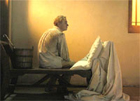The Tulse Luper Suitcases - Part I. The Moab Story (Film) (La Valigia di Luper - Parte I. The Moab Story)
by Peter Greenaway
see also
original title:
The Tulse Luper Suitcases - Part I. The Moab Story
italian title:
La Valigia di Luper - Parte I. The Moab Story
directed by:
cast:
JJ Feild, Raymond J. Barry, Valentina Cervi, Caroline Dhavernas, Anna Galiena, Isabella Rossellini, Drew Mulligan, Cristina Moglia, Steven Mackintosh, Jordi Mollà, Ornella Muti, Nilo Zimmerman, Ronald Pickup, Francesco Salvi, Francesco Guzzo, Andrew Fitch, Keram Malicki-Sánchez, Benjamin Davies, Porgy Franssen, Scot Williams, Debbie Harry, Franka Potente, Ana Torrent, Yorick van Wageningen, Joan-Francesc Ainaud, Roberto Citran, Remo Girone, Michèle Bernier, Albert Kitzl, Nigel Terry, Kevin Tighe, Jack Wouterse, Enrique Alcides
screenplay:
cinematography:
editing:
set design:
Billy Leliveld, Márton Ágh, Davide Bassan, Pirra Jesús Lorenzo, Bettina Schmidt
costume design:
Andrea Flesch, Marrit van der Burgt, Beatrice Giannini, Dawn Thomas-Mondo
music:
producer:
Kees Kasander, Gherardo Pagliei, Jimmy De Brabant, Eva Baró, Antoni Solé, Sándor Söth, Bob Bellion, Elisabetta Riga, Aron Sipos, Victoria Goodall, Aleksandr Mikhaylov, Klaus Volkenborn
production:
Gam Film, supported by Ministero della Cultura, ABS Production, Delux Productions, Focusfilm Kft., Intuit Pictures, Kasander Film Company, NET Entertainment, Studio 12-A
distribution:
world sales:
country:
UK/Netherlands/Spain/Luxembourg/Italy/Hungary
year:
2003
film run:
126'
format:
HD - colour
aspect ratio:
16:9
sound:
Dolby -E Surround
release date:
23/01/2004
festivals & awards:
- Anonimul 2005: Gala Presentation
- Istanbul Film Festival 2005: Mined Zone
- Mexico City's International Contemporary Film Festival 2005: Parallel Focuses: Galas
- Sofia International Film Festival 2005: Directors in Spotlight
- Tribeca Film Festival 2005: Special Screening
- Hong Kong International Film Festival 2004: Master Class
- Istanbul Film Festival 2004: Mined Zone
- Mar del Plata International Film Festival 2004: Section: Punto de Vista
- Montreal Festival du Nouveau Cinéma 2004: Events
- Philadelphia Film Festival 2004: International Master
- Seattle International Film Festival 2004: Contemporary World Cinema
- Singapore International Film Festival 2004: British Cinema
- Chicago International Film Festival 2003: Special Presentation
- Festival de Cannes 2003: In Competition
- Festival do Rio 2003: Panorama
- Festival Internacional del Nuevo Cine Latinoamericano 2003
- International Film Festival Bratislava 2003: Premieres
THE TULSE LUPER SUITCASES is a sweeping trilogy/epic about the life and times of Tulse Luper, a man bigger than the world itself. The film covers some sixty years of recent history from 1928 when the existence of a substance called Uranium was discovered, to the collapse of the Berlin Wall and the end of the Cold War in 1989.
Tulse Luper, a writer and project-maker, is caught in a life of prisons. There are a total of sixteen prisons in the story starting in South Wales, when Luper is ten years old, locked up for three hours by his father in a coalhouse for running the gauntlet of a series of backyard gardens to sign his name on a crumbling brick wall that collapses. Twelve years later in 1938 in Moab, Utah, Luper is arrested through his contact with an American-German family about to travel to Europe to engage exploitatively in the Second World War. Four members of this family, deeply fascinated with Luper, will act as his jailers, with others interested in uranium, around Europe for the next ten years. In the Cold War years he is imprisoned in Moscow and Siberia, before appearing in Hongkong and Kyoto. In the 1980s Luper was apparently sighted in Beijing and in Shanghai. He was last seen in a Manchurian desert. Luper learns to use his prison time, writing on the prisons walls, inventing projects in literature, theatre, film and painting, and engaging with his jailers in all manner of plots, schemes and adventures. Because of their responsibilities, jailers are as much prisoners of their prisoners as they are freemen, and this connection between jailer and prisoner permeates this project and provides a great deal of its drama.
As Luper's reputation as a writer and project-maker grows in Europe and America, so his person becomes more fictional. A large "Luper" Symposium and Exhibition is held in the Brooklyn Museum in New York. Many Luper lecturers offer their theories and propositions on the various stages of Luper's life. The central exhibit of the conference and exhibition is a collection of 92 suitcases - 92 appropriately being the atomic number of Uranium - suitcases that Luper had supposedly been associated with in his travels and prisons. Over the years, the suitcases come to light all over the world.






